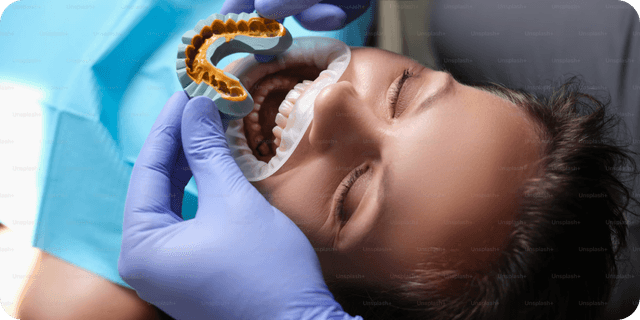Cosmetic Dentistry
7 min read
Nov 28, 2024
Oral Health and Systemic Wellness: Bridging the Gap
Oral health is key to overall wellbeing, influencing heart, metabolic, respiratory, and maternal health. Discover how a healthy mouth supports a healthier body.

Most people brush because they want to keep their teeth shiny, but the importance of oral health runs far deeper than a confident grin. Growing evidence links the health of your mouth to your overall health, and global public health experts now call the mouth a “mirror” that reflects what’s happening everywhere else in the body.
World Health Organization data show that the global burden of oral disease affects nearly half the planet, proving that health is often won or lost starting at the gumline. When we ignore bleeding gums or skip preventive visits, we’re not just risking cavities, we’re nudging the rest of our body toward trouble it never signed up for.
Oral Health: More Than Teeth and Gums
“Oral health” might sound limited to brushing and flossing, yet the oral cavity plays a starring role in digestion, speech, immunity, and even self-esteem. Without good oral routines, plaque hardens, bacteria flourish, and gum disease begins its silent takeover. Early gingivitis can advance to periodontal disease, an infection that dissolves the bone anchoring teeth.
Those microbes don’t stay put; they catch a ride through the bloodstream, creating a significant link between oral health and systemic conditions elsewhere. Beyond cosmetic appeal, many wonder, can veneers fix gaps in ways that also support long-term gum health?
Overall Health: One Body, One Story
Think of the body as a single neighborhood with open streets. When pathogens leak from inflamed gums into circulation, they set off alarms in distant organs. Cardiovascular disease, heart disease, and stroke have all been associated with oral health problems. Researchers in the Journal of the American Dental Association report that people with severe periodontal disease may double their risk of heart attack.
Fixing alignment isn’t always orthodontic, veneers for crooked teeth can offer fast cosmetic fixes while avoiding infection pockets. The relationship between oral health and diabetes is also two-way: uncontrolled blood sugar can worsen gum inflammation, and chronic gum infection makes glucose harder to manage.
Wellness: Connecting Daily Habits to Lifelong Outcomes
Wellness is not a spa weekend, it’s how our choices stack up over decades. Good oral care, brushing twice, flossing daily, and eating fiber-rich foods, promotes a balanced oral microbiome. That same microbiome helps regulate nitric oxide levels that relax blood vessels, benefiting cardiovascular disease prevention. Poor oral hygiene, on the other hand, seeds inflammation that can tax the immune system and erode health-related quality of life.
Your morning routine is either fueling wellness or feeding systemic disease; there is no neutral gear. It’s worth weighing the differences in outcomes between veneers vs Invisalign for patients with both cosmetic and functional bite concerns.
Dental Care and Oral Hygiene: The Hands-On Stuff
Regular dental care is the muscle behind statistics that show falling cavity rates in communities with access to dental veneers. Dental check-ups and professional cleanings sweep away tartar your toothbrush can’t budge, provide fluoride boosts, and let the dentist track oral health status before small issues explode into bigger dental problems. A crucial step in prevention and care is knowing how to choose a veneer dentist who understands both aesthetics and long-term gum support.
Systemic Health: Why Distance Is an Illusion
Systemic health means every tissue talking to every other tissue through hormones, nerves, and the immune highway. When chronic periodontal disease lingers, inflammatory markers like C-reactive protein climb, nudging cardiovascular disease progression. The National Institutes of Health calls this the oral-systemic health connection, one saliva sample can flag red alerts as surely as a blood test.
Scientists have uncovered associations between oral health and respiratory infections, rheumatoid arthritis, and adverse pregnancy outcomes, reminding us that systemic disease does not respect anatomical borders. The veneers procedure is often mistaken for purely cosmetic improvement, but any oral work carries implications for the bloodstream and immune response.
Good Oral vs Poor Oral Health: Two Diverging Roads
Good oral habits build a resilient barrier. Brushing with fluoride paste, using alcohol-free mouth-rinse, and cleaning the tongue improve oral and systemic health by reducing the daily microbial load. Poor oral health, skipped floss, excessive sugar, cigarettes, creates a breeding ground that can increase the risk of oral tumors and systemic complications.
The dramatic shift in oral wellness shown in veneers before and after cases reinforces how small dental changes can ripple into systemic gains. Understanding the differences between porcelain vs composite veneers can shape cosmetic decisions that support both function and wellness.
Health Conditions and the Oral Cavity: The Inside Story
Certain health conditions affect oral health directly. Sjögren’s syndrome dries salivary glands, making cavities bloom. Osteoporosis drugs can slow bone turnover in the jaw, complicating dental extractions. Conversely, gum disease worsens chronic obstructive pulmonary disease flare-ups.
In patients with fragile enamel, decisions between veneers vs crowns should be made in consultation with dental professionals familiar with systemic interactions. Concerns like are veneers painful come up often, especially when patients already experience chronic pain from systemic conditions.
Dental Health and Oral–Overall Health: Drawing the Line
Dental health is not a luxury add-on; it is basic infrastructure for general health and well-being. Studies in health sciences programs stress that ignoring swollen gums can shave years off life expectancy. Connections between oral bacteria and arterial plaque illustrate how the link between your oral health and arterial health can be immediate, not theoretical. While some opt for bonding, others choose veneers; understanding veneers vs dental bonding options can align both cosmetic goals and oral function.
Linked to Oral Health: What the Science Says
Meta-analyses show systemic disease outcomes improve when periodontal therapy reduces bacterial load. Systemic health conditions such as chronic kidney disease share inflammatory pathways with gum disease, and treating one often calms the other. Maintaining enamel integrity is vital, can you get cavities under veneers is not a rhetorical question but a call for long-term care planning. Patients often ask, are veneers reversible, especially when considering long-term maintenance and systemic sensitivities.
Oral Health and Systemic Health: Why Integration Matters
The Department of Health and Human Services says integrating oral care into health plans could slash overall costs. Medical and dental professions must ditch their silo mind-set, sharing electronic records and aligning insurance codes. A practical approach to health means hygienists flag high blood pressure before hygienic polishing ends, while physicians remind patients how medications might impact oral health needs such as salivary flow.
Benefits of Good Oral Health
Good oral health reduces the burden of chronic inflammatory diseases, improves cognitive function in seniors, and boosts self-confidence in social settings. The benefits of good oral health ripple outward, fewer missed workdays, lower prescription costs, and a happier microbiome supporting nitric oxide for vascular tone. Improve oral health and systemic markers like HbA1c often follow suit.
For many, financing veneers is part of the wellness investment, especially when improving oral structure prevents larger systemic issues.
Consequences of Poor Oral Health
Poor dental health drives billions in emergency spending each year and is associated with oral health-related losses in school attendance among children. The global burden of oral conditions includes preventable tooth decay that still ranks as the most common chronic illness worldwide. In fact, veneers cost becomes a much larger concern when minor issues are ignored, leading to compounded oral complications.
Consequences of poor oral health reach beyond pain; they undermine nutrition, speech development, and even job prospects.
Practical Tips for Bridging the Gap
Brush twice daily with a fluoridated paste and replace your brush every three months to maintain oral health and its connection to systemic wellness. People committed to brushing ask, how long do veneers last when you stick to the basics, fluoride, floss, and fiber.
Floss or use interdental cleaners once daily, without good oral interdental care, plaque thrives where brushes can’t reach.
Swish with a non-alcohol mouth-rinse to lower bacterial counts and improve oral hygiene quickly on hectic days.
Eat a rainbow of crunchy fruits and vegetables; their fiber scrubs enamel and feeds beneficial oral microbiome species.
Drink tap water if fluoridated; it strengthens enamel and supports public health goals on community prevention.
Quit smoking and limit alcohol to reduce the risk of oral cancers and systemic complications.
Schedule professional cleanings every six months; early detection keeps management of oral issues less invasive.
Replace your brush every three months and learn how to maintain veneers properly if you have them, to protect your oral health investment.
Discuss medications with both dental and medical providers so you can manage dry mouth and bleeding risk proactively.
If you have diabetes, work closely with your dentist, improve oral and systemic health together by taming gum inflammation and stabilizing blood sugar.
Closing Thoughts
There is no firewall between the mouth and the rest of the body. Medical and dental collaborations, better access to dental services, and everyday habits can all narrow the gap between oral and systemic wellness. Before you grab that cup of coffee, remember to ask your dentist, do veneers stain, and how does staining relate to inflammation risks?
When we treat brushing as a small daily investment instead of a chore, we guard not only our smile but our heart, lungs, joints, and even the brain. That is a trade worth making, one toothbrush, two minutes, twice a day, for a lifetime of stronger, healthier tomorrows.
How Does Oral Health Affect Overall Health?
Oral health is deeply connected to overall health through shared pathways like inflammation and circulation. Bacteria from gum disease can enter the bloodstream and contribute to systemic conditions such as heart disease, stroke, diabetes, and even respiratory infections. Taking care of your mouth supports your entire body.
What Are the Consequences of Poor Oral Hygiene?
Neglecting oral hygiene can lead to gum disease, tooth loss, and chronic inflammation that may affect organs like the heart and kidneys. Poor dental health also increases the risk of oral cancers, worsens diabetes control, and can impact nutrition, speech, and even job opportunities.
Can Good Oral Health Prevent Other Diseases?
Yes, maintaining oral health can reduce your risk for several chronic conditions. Brushing, flossing, and regular dental visits help lower inflammation, protect your immune system, and may improve outcomes for diseases like diabetes and cardiovascular disease. It’s a key part of preventive healthcare.
Are Veneers Just Cosmetic, or Can They Support Oral Health Too?
While veneers are primarily cosmetic, they can help protect damaged enamel, close gaps that trap bacteria, and create surfaces that are easier to clean. When done properly, veneers can complement good oral hygiene and support long-term gum and tooth health, especially when combined with regular care.
Read Next
Related Posts

Cosmetic Dentistry
Looking for a Dentist Who Whitens Teeth? Here’s What to Know First
A brighter smile can do wonders for your confidence, but finding the right dentist who whitens teeth takes more than just a quick Google search. From treatment options to experience and safety measures, there are a few key things you should know before booking that whitening appointment.
3 min read
Sep 10, 2025

Cosmetic Dentistry
What Type of Dentist Does Veneers? Here’s Who to Trust With Your Teeth
Dreaming of a flawless, photo-ready smile? Veneers can be a game-changer, but only if you choose the right expert to apply them. Understanding who’s qualified to handle this cosmetic procedure is key to getting results that look natural and last for years.
5 min read
Sep 08, 2025

Cosmetic Dentistry
Cosmetic Dentistry and Implants: How They Work Together
A confident smile can do wonders for your self-esteem, and modern dentistry offers more ways than ever to achieve it. Whether you're dealing with missing teeth or simply want a brighter, more balanced look, cosmetic dentistry and dental implants provide powerful solutions that work hand-in-hand to restore both function and aesthetics.
5 min read
Sep 05, 2025
Don’t have time to research every dentist around you?
See why 30k+ patients trusted us